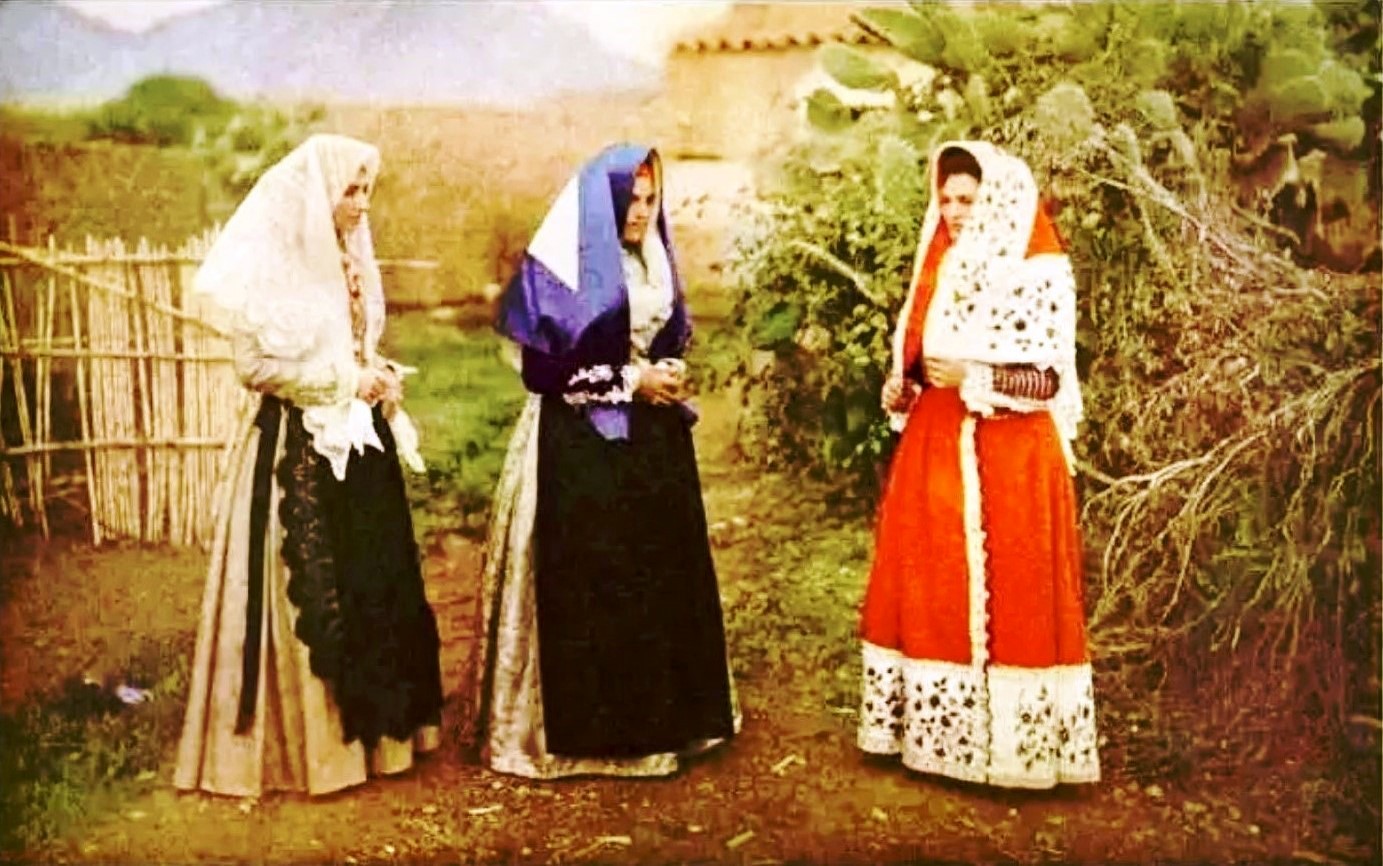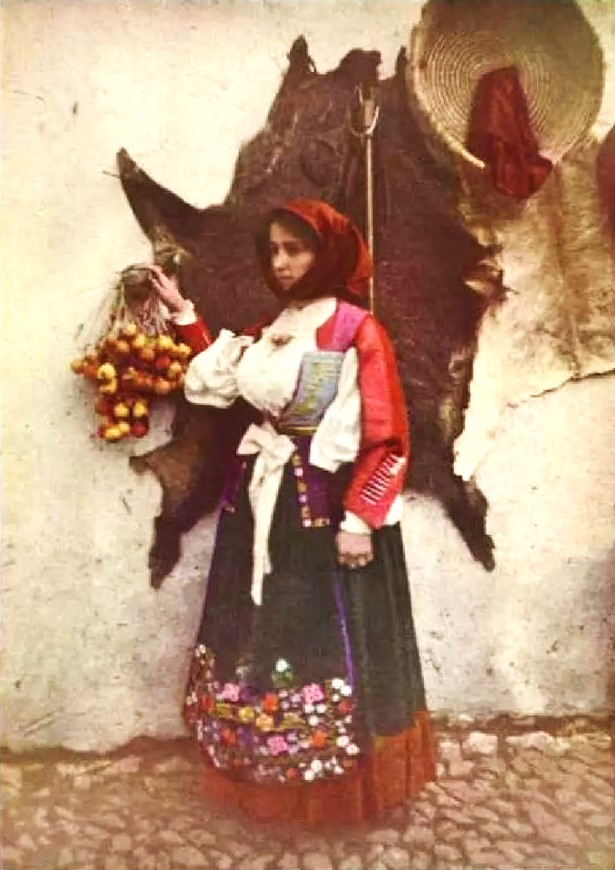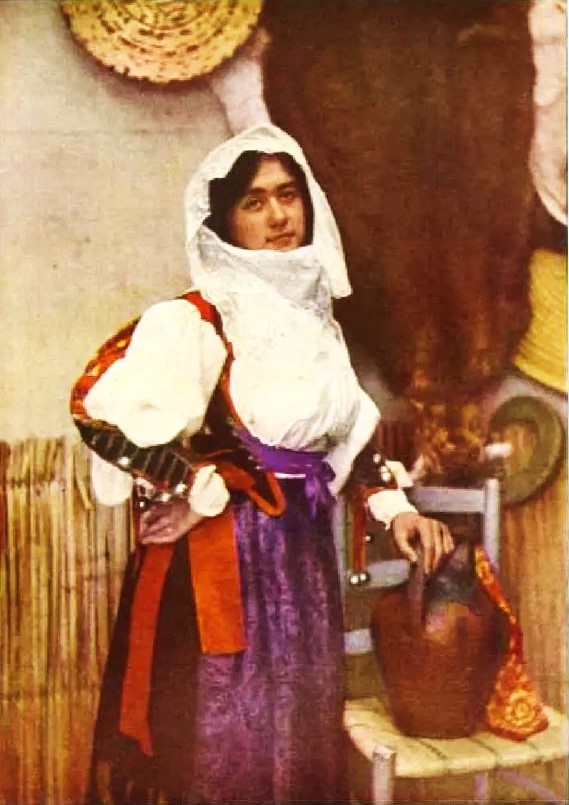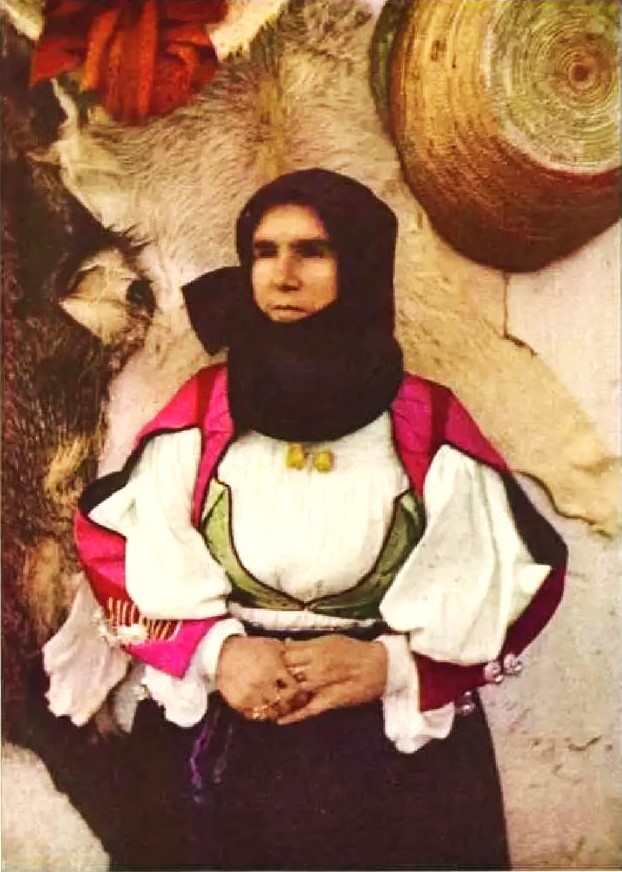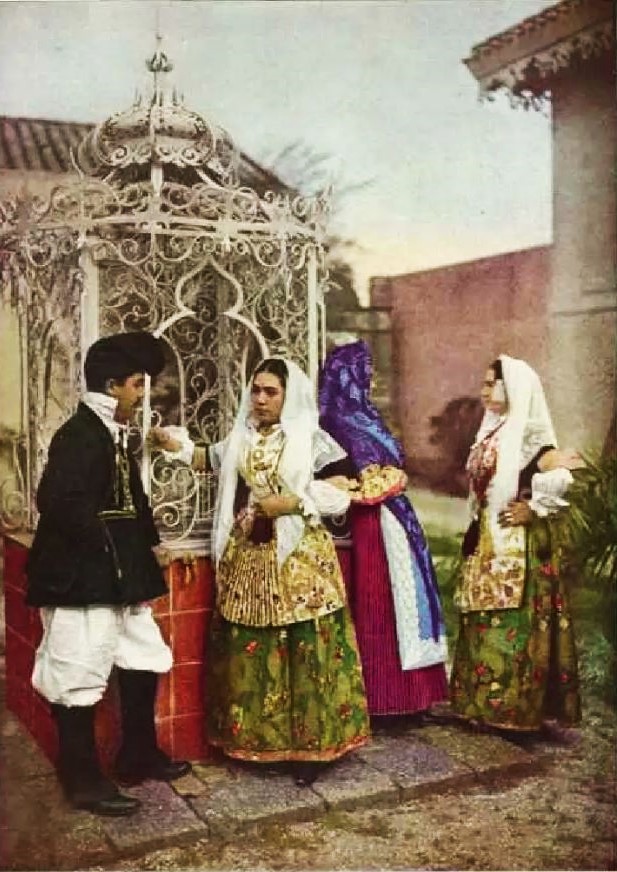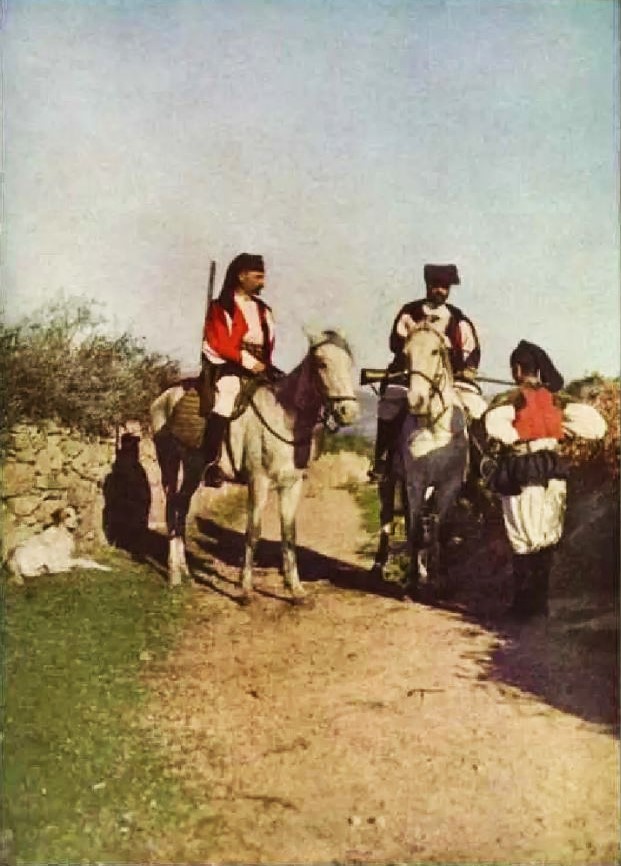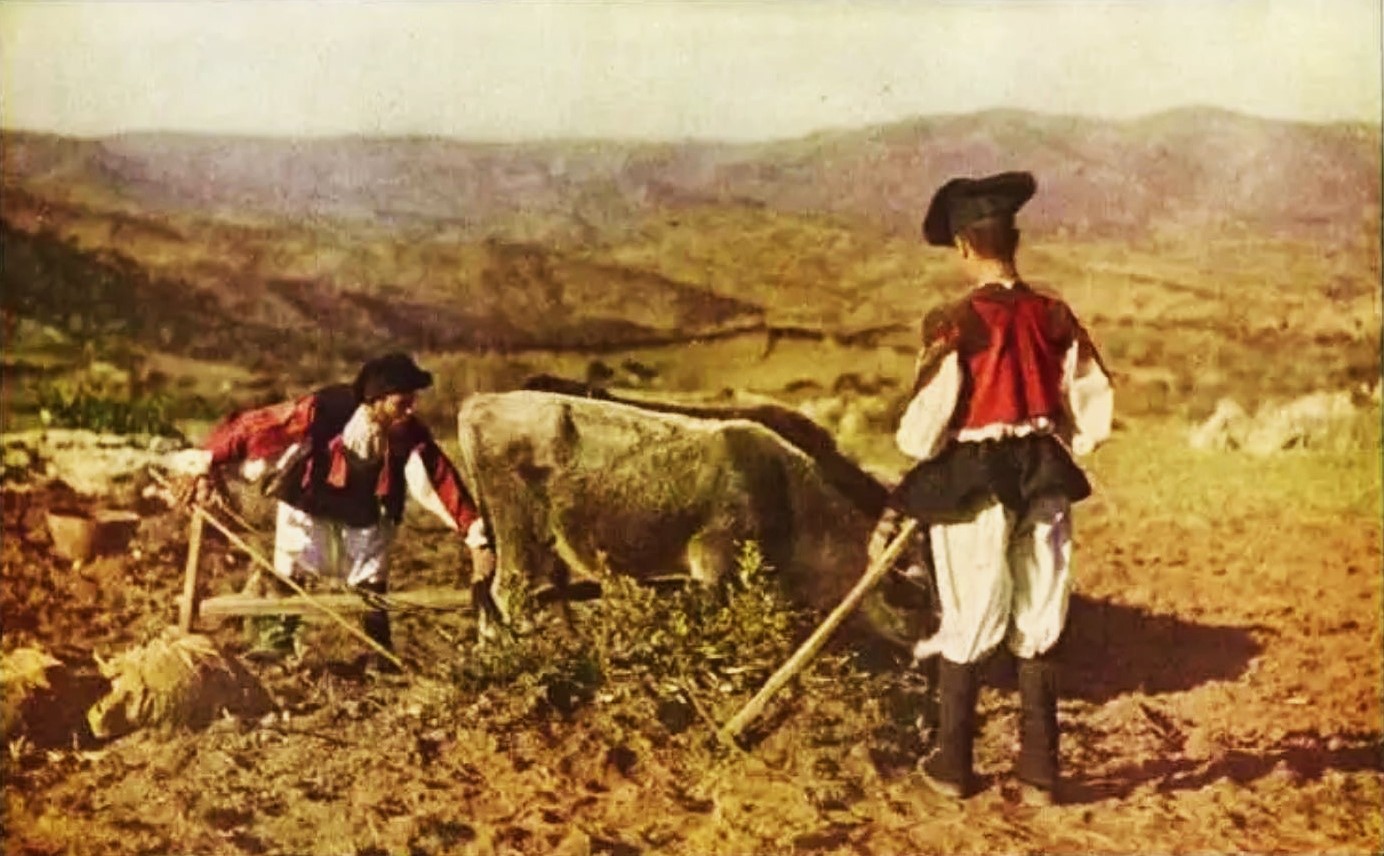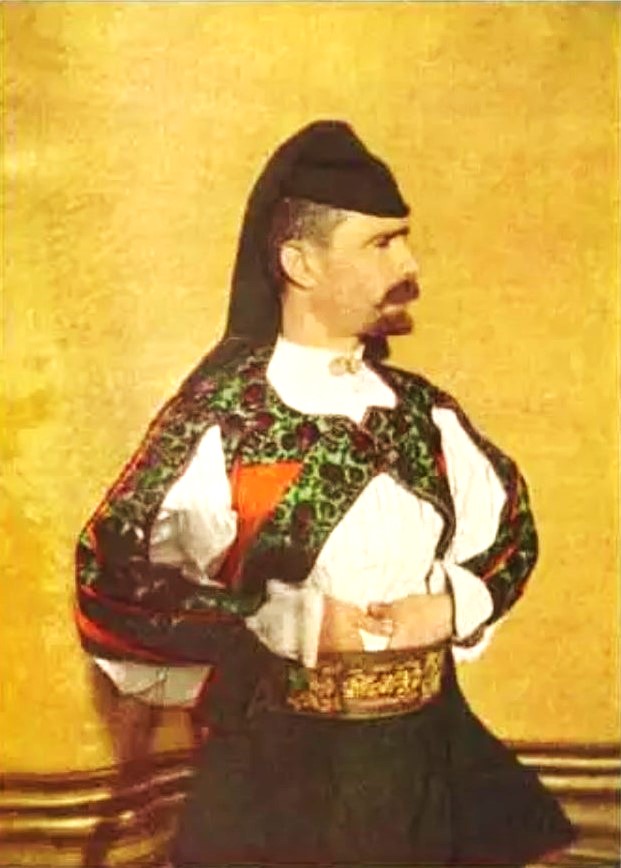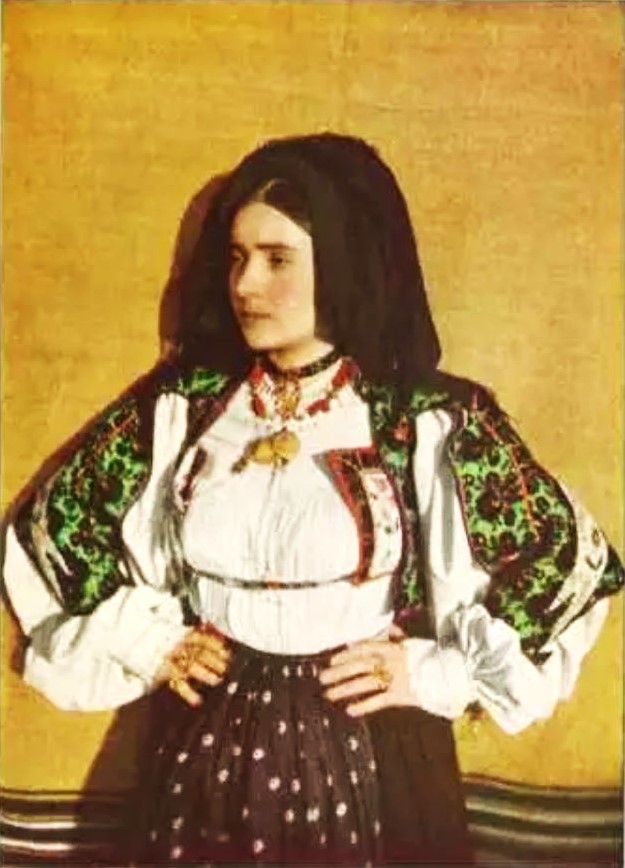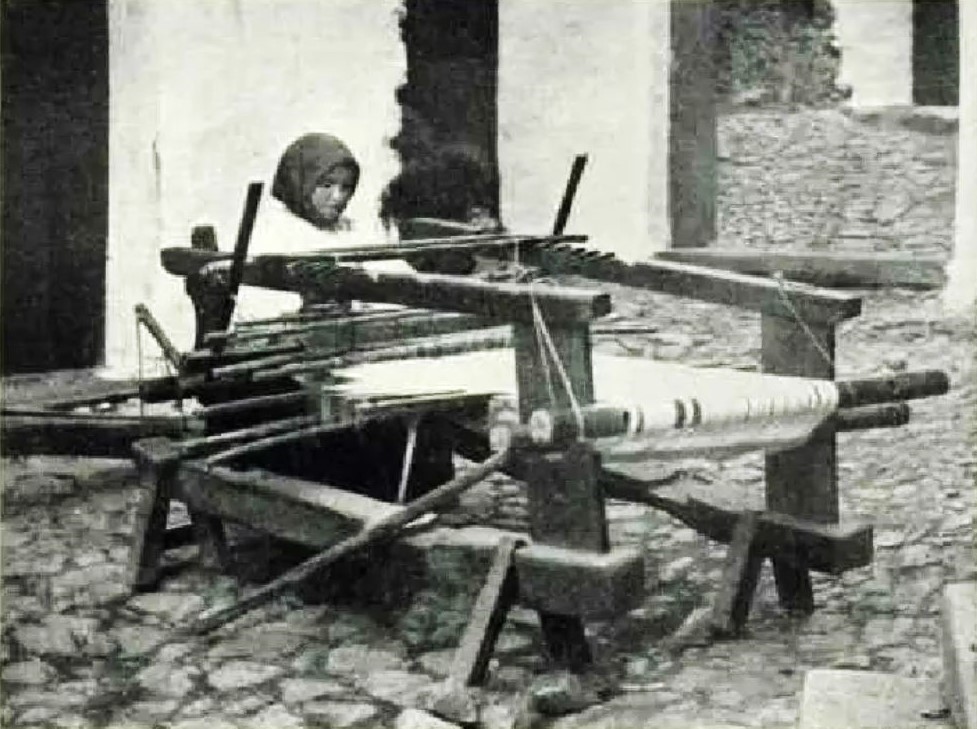WHERE THE SARD HOLDS SWAY
WITH ILLUSTRATIONS FROM NATURAL-COLOR
Photographs by Colonel LUIGI PELLERANO
THE NATIONAL GEOGRAPHIC MAGAZINE ⇒
Vol. XLIX, No. 4 – April, 1926 ⇒
in italian ![]()
IN MOST other parts of Europe fine old costumes of other days have entirely disappeared, but in Sardinia, if one visits the right places at the right time, beautiful souvenirs are still to be found of times when the pageantry of the Middle Ages expressed itself even in the everyday dress of the common people.
There are almost as many variations of costume on this Mediterranean island as there are villages, for each little community has some feature of its own. In one locality a certain combination of colors may be used exclusively, while in another the cut of the apron or the arrangement of the headdress may be the distinguishing characteristic.
These differences in village styles were once to be found all over Europe and may be traced to the remoteness and comparative isolation of places in medieval times. On the Continent they have been ironed away by contact, but in Sardinia efficient and easy means of transport are of more recent development, and some of its mountain solitudes have not yet felt the full force of this standardizing influence.
A SOBER-MINDED PEOPLE FOND OF COLORS
Although the Sards are essentially a sober-minded people and not particularly addicted to display in other respects, their costumes are riots of blue, scarlet, orange, green, and all the shades that go between. These are often elaborately embellished with embroidery, gold lace and brocade, and gold and silver buttons. Many of the finer ones have been handed down from generation to generation and possess, in addition to their not inconsiderable intrinsic value, the sentimental significance of heirlooms.
While varying so widely in color and style, there are certain features common to nearly all the island costumes. The apparel of the Sardinian woman consists of a heavy skirt of silk or wool, a white waist, a colored bodice or corset, an apron, and a sort of kerchief to cover the head.
The skirt is sometimes of a sober hue, but may be of scarlet, blue, orange, or purple [see Color Plate I]. Over it is worn the apron, which is nearly always of a brilliant color and varies greatly in size and shape with the locality.
[Color Plate I] – VARIETY IN COSTUMES REFLECTS THE DIVERSE INFLUENCES WHICH HAVE FLAVORED SARDINIAN LIFE – Autochrome by Luigi Pellerano
The mother and daughter, at the left, wear the relatively somber garb of the southern mining region, while the brilliant plaited skirt and elaborate embroidery worn by the young woman at the right proclaim her as a resident of Osilo, a northern village which boasts the most beautiful costumes in Sardinia.
The women of Aritzo, who wear one of the richest and most original costumes on the island, affect a tongue-shaped apron of scarlet, faced and banded in bright blue. Other villagers wear long, dark aprons much embroidered in bright colors (see Color Plate VII), while still others wear fan-shaped ones with a ruby-red center and a wide white border garnished with figures of blue and gold.
The white waist is worn beneath the bodice, and the kerchief, perhaps white, but generally of bright hue, covers the head and sometimes the shoulders, and is brought together under the chin with a fancy pin (see Color Plates I and II).
[Color Plate II] – SHE DWELLS IN THE HIGHLANDS OF NUORO – Autochrome by Luigi Pellerano
In this section of the island, known as the Switzerland of Sardinia, the women have retained old fashions unaltered, but in most other districts the peasant costumes which have been handed down for generations as family heirlooms are rapidly disappearing.
The exact origin of this kerchief or head-cape is unknown, but it dates far back into antiquity, as the head of a statuette of the Goddess Vesta in the Etruscan Museum at Gori, Italy, is draped in much the same style as that popular with the women of Sardinia today.
So impressive are the costumes of some of the peasants that the occasion of their leaving church on Sundays and fête days has been likened to a scene at the court of some prince of the Arabian Nights. The flaming reds, blues, and purples are frequently decorated with gold lace and brocade, and as the worshipers descend the church steps with their silver and mother-of-pearl rosaries in their hands. the richness of their costumes, the beauty of their faces, and the background of odd balconied houses all combine to produce a truly medieval atmosphere. Last among the women come the widows, dressed usually all in black.
Red or scarlet is ordinarily the color of youth and, with bright blue, is utilized in nearly every variation of costume. There are other colors that have special significance when worn in certain ways, as, for instance, in Desulo a purple border appearing on an apron signifies that the wearer has lost her parents. In some communities if a woman is widowed she must forever forswear the use of scarlet, even though she marry again.
[Color Plate III] – A FAIR SASSARESE – Autochrome by Luigi Pellerano
She dwells among the gray-leaved olive groves and vast vineyards of the northern province of Sassari, and speaks a Tuscan dialect, recalling the fact that in the Middle Ages her city was a Pisan colony.
THE WIDOW’S MOURNING USUALLY LASTS FOR LIFE
The widow’s dress is not the same throughout the island. While in most places she must wear the black habit of mourning all her life and endure an existence as somber as the color of her garments, in some villages only a kerchief of black is worn, and she may continue to gratify her love for bright colors in the rest of her costume.
[Color Plate IV] – THE WIDOW SWATHES HER FACE IN BLACK- Autochrome by Luigi Pellerano
The Nuoro pasant does not pernit her bereavement to rob her custume of volor and orna ment, however. The double button at the nock is a feature which is common to many districts of the island [see also Color Plates II e VI-B].
The men of Sardinia also have an interesting heritage of costumes which, while they differ with locality like the women’s, show fewer marked variations. Generally speaking, a man wears knee-length or longer, bell-shaped, baggy trousers of white and either leggings of coarse serge or high spats.
Over a white shirt is worn a gayly colored vest, sometimes closed to the neck, sometimes a cutaway, and over this a small doublet.
Around the masculine waist is often wound a Turkish sash, which in ancient times was used to carry a dagger, but now conceals nothing more deadly than a pipe.
The Sard confines his hair beneath a little black skullcap, over which he wears a regular Sardinian cap-a narrow cloth bag, closely resembling the old American stocking-cap-which, in addition to being a head covering, serves as a lunch bag and valise in the daytime and as a pillow at night. [See Color Plates V, VI, VII].
[Color Plate V] – CAMPIDANO COURTSHIP – Autochrome by Luigi Pellerano
Among the villages of the great Sardinian plain (Campidano), which stretches for fifty miles from citadel-crowned Cagliari to Oristano, these brilliant and costly peasant costumes are seldom seen nowadays. The beautifully fabricated grillwork over the well is a relic of the age when Spain dominated this island hub of the western Mediterranean
(see “The Island of Sardinia and Its People“, in The National Geographic Magazine, for January, 1923).
[Color Plate VI] – A SERVANT SALUTES TWO GENTLEMEN OF OLIENA – Autochrome by Luigi Pellerano
Wealthy farmers, when traveling along mountain trails, still carry their guns, though the banditry of the open road has become a mere tradition. The man on foot carries his lunch in the end of his berretta, or long cap.
[Color Plate VII] – SARTORIAL SPLENDOR DISTINGUISHES THE SARDINIAN OF THE INTERIOR – Autochrome by Luigi Pellerano
These mountain farmers consider such bright-colored, everyday woolen garments as fit only for the fields; on Sunday they don their best and go calling on their neighbors. This type of handmade wooden plow is used only in the mountain districts, where the turf is of little depth.
Many villagers also wear the ragas, a peculiar sort of short overskirt not unlike a Scotch kilt (Plate VIII-A), or a pair of short, balloonlike top trousers that extend only to the middle of the thigh (Plate VII).
The shepherds of such villages as Fonni (from the Phoenician word phanna, meaning “elevated view”) wear the mastruca, a sleeveless fleecy sheepskin jacket. Gun, pipe, and bandoleer are carried as inseparable companions.
[Color Plate VIII, A] – GREEN GIVES THE COLOR NOTE TO OLIENA’S GALA COSTUMES – Autochrome by Luigi Pellerano
Only on feast days and Sundays do the men of Oliena wear this gay attire.
[Color Plate VIII, B] – GREEN GIVES THE COLOR NOTE TO OLIENA’S GALA COSTUMES – Autochrome by Luigi Pellerano
Many of the Sardinian women have a serenity of expression which would have delighted old masters seeking models for Madonnаs.
The shepherds of such villages as Fonni (from the Phoenician word phanna, meaning “elevated view”) wear the mastruca, a sleeveless fleecy sheepskin jacket. Gun, pipe, and bandoleer are carried as inseparable companions.
The Sards are a brave, hardy, liberty-loving people, whose history has been one long and continuous struggle for existence against alien peoples that have so repeatedly assailed their shores. This bitter experience has served to accentuate and develop their native qualities, and the Sardinian soldiers who fought for Italy in the World War well demonstrated their courage and the ability of their race to endure hardships and privations.
Although these people have maintained their individuality in the face of great oppression, they could not but feel the influence and bear some of the impress of the many races that have occupied their island in the last 25 centuries. Italian, Spanish, and Saracenic influences are all to be found in their costumes.
Probably as early as 500 B. C. there is record of the presence of Phoenician settlers in Sardinia, and Carthage maintained her sovereignty over the island until 238 B. C., when the proud mistress of North Africa had to bow to the superior power of Rome and her insular possession was declared a Roman province.
THE SARDS NEVER SUBMITTED TO THE CESARS
But Rome never quite succeeded in subjugating the Sards, for the mountain dwellers of the Barbagia at that early date gave evidence of the same spirit of independence which has ever since been one of their cardinal characteristics. An unending guerrilla warfare was waged against the legions of the Cæsars. Many of the natives were slaughtered and many more were enslaved and sent to Rome, but never were they wholly subdued. Indeed, so refractory were they in servitude that their Roman masters were glad to be rid of them, and the expression “Sards for sale” became a byword.
Following the dispossession of the Romans, the island was overrun in turn by Vandals, Saracens, Pisans, Genoese, and later by the armies of Aragon, Austria, and Savoy, until finally, during the latter part of the last century, the land became an integral part of the united kingdom of Italy.
Development of natural resources will bring to the Sards material prosperity, but it will at the same time mark the beginning of the end of that picturesque remoteness that has been theirs.
The beautiful costumes that have distinguished the island are here reproduced as a valuable historic record through the medium of natural-color plates, made with rare artistic perception by Col. Luigi Pellerano. They cannot much longer resist the advance of modern styles, but will soon join their counterparts in other lands as colorful memories of the past, to be seen only in museums.
THE WAY IN WHICH SARDINIAN WOOLENS ARE WOVEN – Photograph by Charles Will Wright
The women of the Mediterranean island are industrious and painstaking. Their flocks supply the necessary wool for the yarn from which are woven many of the costumes shown in Color Plates I to VIII.

